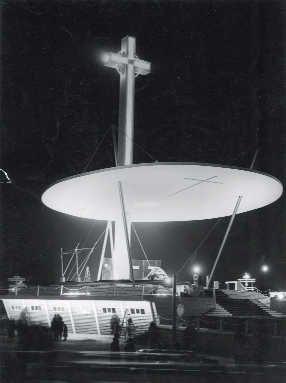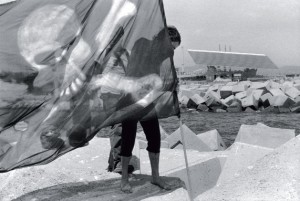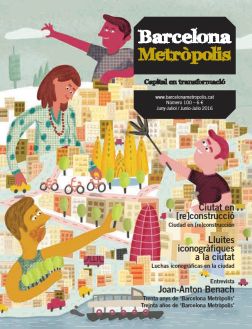Photography as a language of portrayal cannot be decoupled from a city’s symbols: neither the image it projects to the outside world nor the image that the public builds of its own city through the media. The exhibition Barcelona. The metropolis in the age of photography is a history of the self-portrayal of Barcelona.

Photo: Joan Guerrero.
Santa Coloma in 1970: an image that conveys the urban planning undertaken during the Francoist dictatorship in the Barcelona metropolitan area. The photograph is by Joan Guerrero and it is the opening illustration of the catalogue for the exhibition on the image of the city from 1860 to 2004, organised by the Institute of Culture’s La Virreina Centre de la Imatge.
Photography as a language of portrayal cannot be decoupled from a city’s symbols: neither the image it projects to the outside world nor the image that the public builds of its own city through the media. Barcelona. The metropolis in the age of photography, 1860-2004 is the title of the exhibition produced by Barcelona City Council’s Culture Institute and curated by Jorge Ribalta at La Virreina Centre de la Imatge. Along with its catalogue, it revisits 144 years of images produced in and by Barcelona. The exhibition compares and contrasts the official image of the city (ever since Ramon Alabern immortalised the Pla del Palau on daguerreotype) with the way it presents itself to the outside world and with the protests made by members of the Group of Catalan Architects and Technicians for the Advancement of Contemporary Architecture (GATCPAC), neighbourhood movements and photojournalists.
In seventeen sections it explains the six major periods in which Barcelona has produced iconic landmarks: the go-ahead for Cerdà plan’s for the city’s extension and the Universal Exposition (1860-1888); the rise of the illustrated press, the construction of Via Laietana and the landscaping of Montjuïc and the early days of architectural and artistic Modernisme (1888-1929); the thirties and the Spanish Civil War (1930-1939); the predominance of the humanist paradigm and the new photojournalism of the transition to democracy (1940-1970); the birth of the new topographical documentary style and its link to the city’s recovery and the rise in neighbourhood association movements (1970-1992); and, finally, the new social struggles, where the image took on a new central role in both municipal management and social conflict (1992-2004), with the arrival of local government marketing and citizens’ movements to processes such as the redevelopment of El Raval.
The exhibition takes us on a journey though the sedimentary layers of the city, shedding light on the symbols of Barcelona that surround us today, both as local passers-by and as tourists.
Institutional commissions are what draw the lines of the first graphic image of “official” Barcelona. “Souvenir of the visit of Her Majesty’s visit to the city of Barcelona”, reads the footer in a large open album that was a gift for Isabel II on her first visit to the city. Then, electricity and the Universal Exposition of 1888 would come and with them a new injection of urban landmarks with which to export “the Paris of the south”, as was the aspiration of the architect Josep Puig i Cadafalch and of which the most famous example is the Columbus monument. At the beginning of the exhibition and the book, one can see the scaffolding that surrounded the sculpture in 1887.
Later on, the boom time of the mass media would come, bringing these urban symbols into the living rooms of every home in Barcelona. The pioneering magazine La Il·lustració Catalana (Catalan Illustration) was launched and became the principal medium for disseminating Catalonia’s emerging photojournalism. And between 1908 and 1939, the Societat d’Atracció de Forasters (the Society to Attract Visitors) was at work, generating an iconography of Barcelona that aimed to make it a stop on the travellers’ circuits of the day.

Photo: Pérez de Rozas / AFB.
Altar built in the square of Pius XII in Diagonal, on the occasion of the Eucharistic Congress of 1952.
In the 1930s, social documentary photography burst onto the international stage, and in the section on the Civil War visitors to the exhibition can see the first audiovisual testament: a report on the revolutionary movement of 1936. In the second half of the 20th century, the Francoist dictatorship’s propaganda stranglehold led to the 35th Eucharistic Congress, which set out to depict Barcelona in symbols as the city of a Catholic and anti-communist regime.

Photo: Jordi Pons i Secall.
Protest against the Forum of Cultures, in 2004, from the series Barcelona on Barcelona, by Jordi Secall. Image included in the exhibition of La Virreina.
This trend continued until the transition to democracy took hold, when neighbourhood association movements found a space for their discourse in neighbourhood magazines, the “poor press”, as Maria Favà called it. Up to fifty titles were published in the 1970s. This continued until 2004 and the controversial urban development project of the Forum of Cultures.
Barcelona. The metropolis in the age of photography explores the inner workings of an iconography that is sometimes invisible to people who walk with their eyes to the ground, but very present in the imagination of the real and the virtual Barcelona with “the explosion of digital technologies, the Internet, mobile telephony and social media”, as the text of the exhibition states, all of them new producers (and reproducers) of city symbols.



